Hyundai H-100 Truck 2012 Owner's Manual
Manufacturer: HYUNDAI, Model Year: 2012, Model line: H-100 Truck, Model: Hyundai H-100 Truck 2012Pages: 217, PDF Size: 9.37 MB
Page 201 of 217
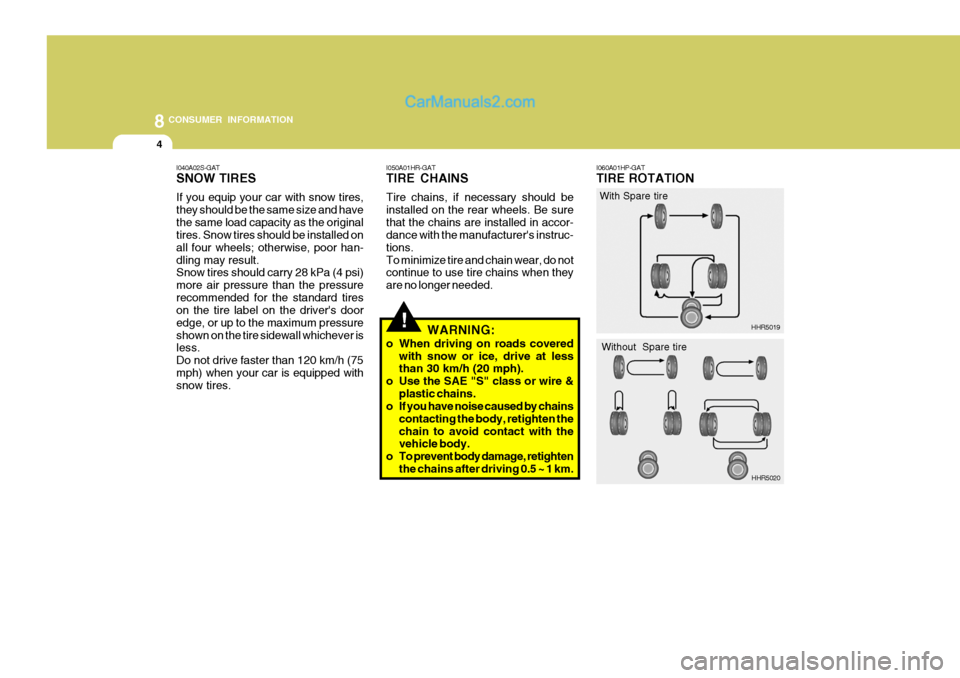
8CONSUMER INFORMATION
4
HHR5019!
I050A01HR-GAT TIRE CHAINS Tire chains, if necessary should be installed on the rear wheels. Be surethat the chains are installed in accor- dance with the manufacturer's instruc- tions.To minimize tire and chain wear, do not continue to use tire chains when they are no longer needed.
I040A02S-GAT SNOW TIRES If you equip your car with snow tires, they should be the same size and havethe same load capacity as the original tires. Snow tires should be installed on all four wheels; otherwise, poor han-dling may result. Snow tires should carry 28 kPa (4 psi) more air pressure than the pressurerecommended for the standard tires on the tire label on the driver's door edge, or up to the maximum pressureshown on the tire sidewall whichever is less. Do not drive faster than 120 km/h (75mph) when your car is equipped with snow tires. I060A01HP-GAT TIRE ROTATION
WARNING:
o When driving on roads covered with snow or ice, drive at less than 30 km/h (20 mph).
o Use the SAE "S" class or wire & plastic chains.
o If you have noise caused by chains
contacting the body, retighten the chain to avoid contact with the vehicle body.
o To prevent body damage, retighten the chains after driving 0.5 ~ 1 km. HHR5020
With Spare tire
Without Spare tire
Page 202 of 217
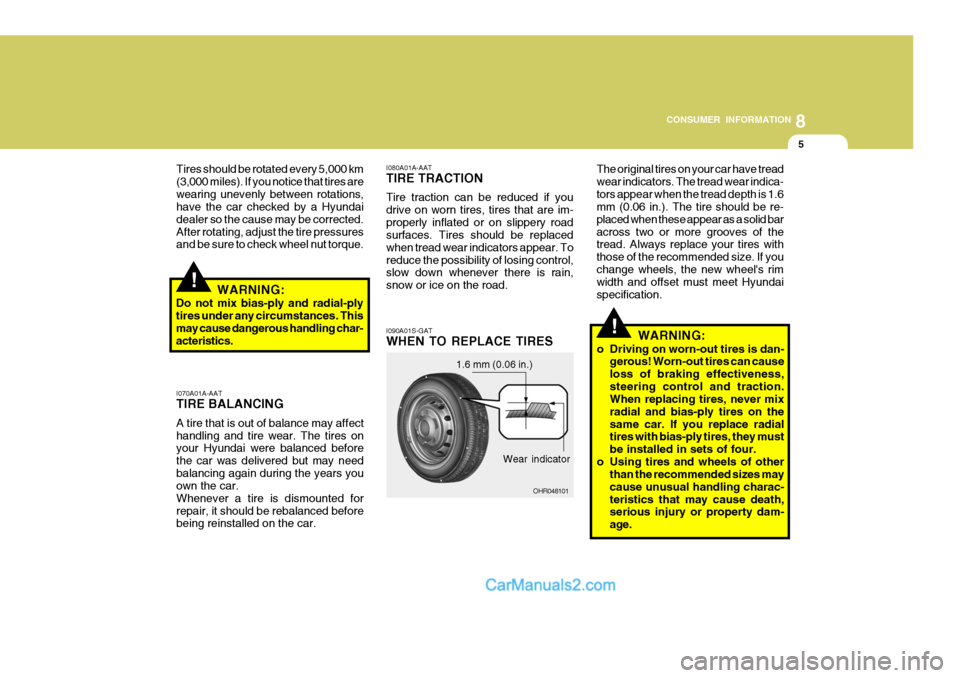
8
CONSUMER INFORMATION
5
!
!
I070A01A-AAT TIRE BALANCING A tire that is out of balance may affect handling and tire wear. The tires on your Hyundai were balanced before the car was delivered but may needbalancing again during the years you own the car. Whenever a tire is dismounted forrepair, it should be rebalanced before
being reinstalled on the car. I080A01A-AAT TIRE TRACTION Tire traction can be reduced if you drive on worn tires, tires that are im-properly inflated or on slippery road surfaces. Tires should be replaced when tread wear indicators appear. Toreduce the possibility of losing control, slow down whenever there is rain, snow or ice on the road. I090A01S-GAT WHEN TO REPLACE TIRES
Tires should be rotated every 5,000 km (3,000 miles). If you notice that tires arewearing unevenly between rotations, have the car checked by a Hyundai dealer so the cause may be corrected.After rotating, adjust the tire pressures and be sure to check wheel nut torque.
WARNING:
Do not mix bias-ply and radial-ply tires under any circumstances. Thismay cause dangerous handling char- acteristics.
Wear indicator
1.6 mm (0.06 in.)
OHR048101 WARNING:
o Driving on worn-out tires is dan- gerous! Worn-out tires can cause loss of braking effectiveness,steering control and traction.
When replacing tires, never mix radial and bias-ply tires on thesame car. If you replace radial tires with bias-ply tires, they must be installed in sets of four.
o Using tires and wheels of other than the recommended sizes maycause unusual handling charac-teristics that may cause death, serious injury or property dam- age.
The original tires on your car have treadwear indicators. The tread wear indica-tors appear when the tread depth is 1.6 mm (0.06 in.). The tire should be re- placed when these appear as a solid baracross two or more grooves of the tread. Always replace your tires with those of the recommended size. If youchange wheels, the new wheel's rim width and offset must meet Hyundai specification.
Page 203 of 217
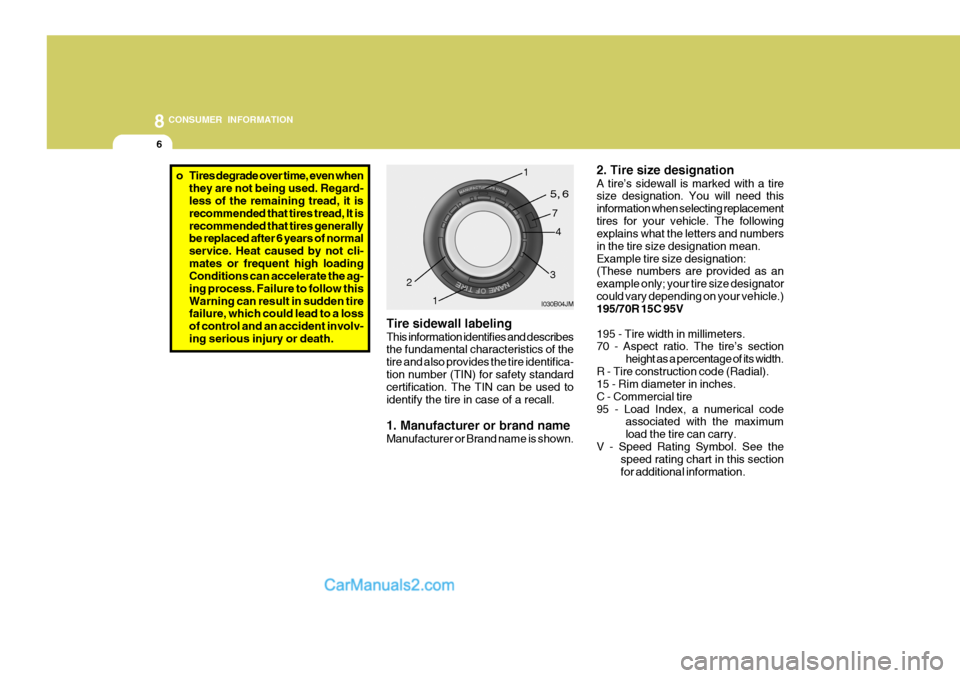
8CONSUMER INFORMATION
6
o Tires degrade over time, even when
they are not being used. Regard- less of the remaining tread, it is recommended that tires tread, It isrecommended that tires generally be replaced after 6 years of normal service. Heat caused by not cli-mates or frequent high loading Conditions can accelerate the ag- ing process. Failure to follow thisWarning can result in sudden tire failure, which could lead to a loss of control and an accident involv-ing serious injury or death. Tire sidewall labeling This information identifies and describes the fundamental characteristics of the tire and also provides the tire identifica-tion number (TIN) for safety standard certification. The TIN can be used to identify the tire in case of a recall. 1. Manufacturer or brand name Manufacturer or Brand name is shown.
I030B04JM
2
1
1
5, 6
7
3
4 2. Tire size designation A tire’s sidewall is marked with a tire size designation. You will need this information when selecting replacementtires for your vehicle. The following explains what the letters and numbers in the tire size designation mean.Example tire size designation: (These numbers are provided as an example only; your tire size designatorcould vary depending on your vehicle.) 195/70R 15C 95V 195 - Tire width in millimeters. 70 - Aspect ratio. The tire’s section
height as a percentage of its width.
R - Tire construction code (Radial).15 - Rim diameter in inches. C - Commercial tire
95 - Load Index, a numerical code associated with the maximumload the tire can carry.
V - Speed Rating Symbol. See the speed rating chart in this sectionfor additional information.
Page 204 of 217
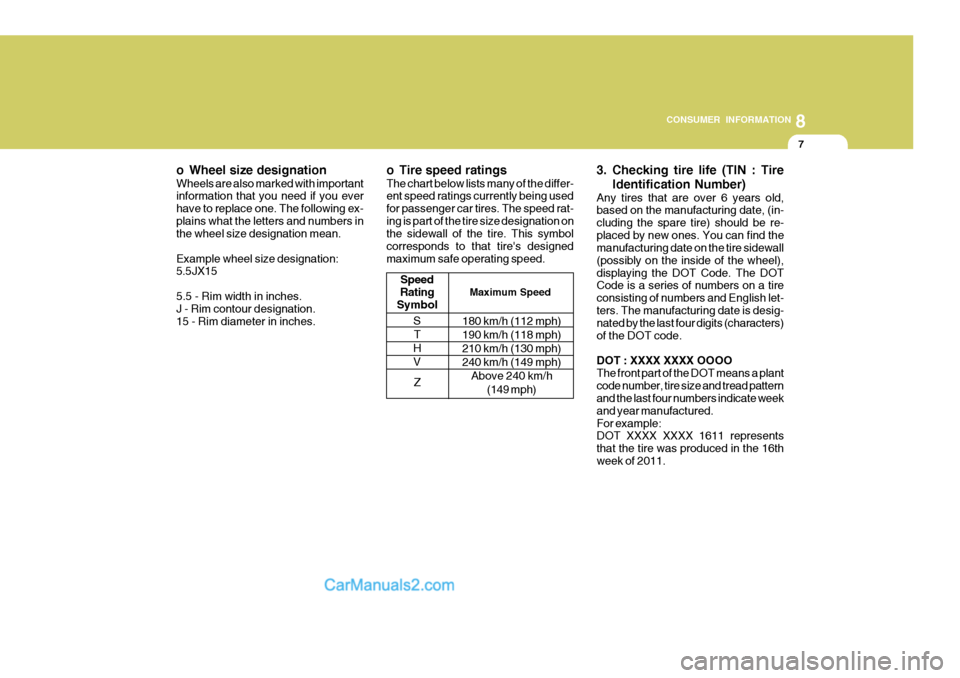
8
CONSUMER INFORMATION
7
o Wheel size designation Wheels are also marked with important information that you need if you ever have to replace one. The following ex-plains what the letters and numbers in the wheel size designation mean. Example wheel size designation:
5.5JX15 5.5 - Rim width in inches. J - Rim contour designation. 15 - Rim diameter in inches. o Tire speed ratings The chart below lists many of the differ- ent speed ratings currently being used for passenger car tires. The speed rat-ing is part of the tire size designation on the sidewall of the tire. This symbol corresponds to that tire's designedmaximum safe operating speed.
3. Checking tire life (TIN : Tire
Identification Number)
Any tires that are over 6 years old, based on the manufacturing date, (in- cluding the spare tire) should be re-placed by new ones. You can find the manufacturing date on the tire sidewall (possibly on the inside of the wheel),displaying the DOT Code. The DOT Code is a series of numbers on a tire consisting of numbers and English let-ters. The manufacturing date is desig- nated by the last four digits (characters) of the DOT code. DOT : XXXX XXXX OOOO The front part of the DOT means a plantcode number, tire size and tread pattern and the last four numbers indicate week and year manufactured.For example: DOT XXXX XXXX 1611 represents that the tire was produced in the 16thweek of 2011.
Speed
Rating
Symbol Maximum Speed
180 km/h (112 mph) 190 km/h (118 mph)210 km/h (130 mph)240 km/h (149 mph)
Above 240 km/h (149 mph)
S
T
HV
Z
Page 205 of 217
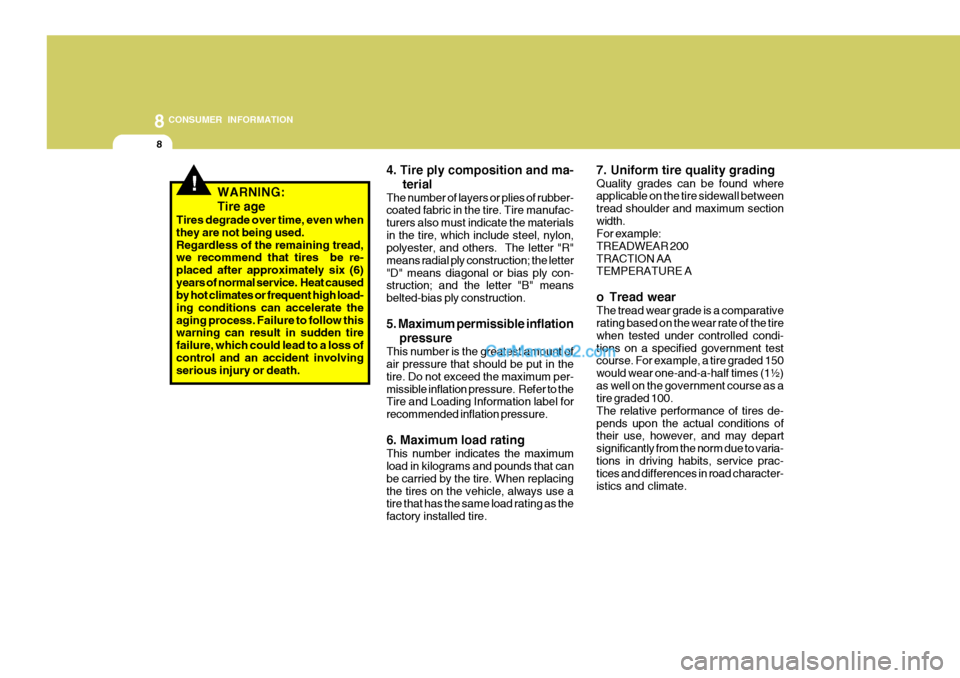
8CONSUMER INFORMATION
8
7. Uniform tire quality grading Quality grades can be found where applicable on the tire sidewall between tread shoulder and maximum sectionwidth. For example: TREADWEAR 200TRACTION AA TEMPERATURE A
o Tread wear The tread wear grade is a comparative rating based on the wear rate of the tire when tested under controlled condi-tions on a specified government test course. For example, a tire graded 150 would wear one-and-a-half times (1½)as well on the government course as a tire graded 100. The relative performance of tires de-pends upon the actual conditions of their use, however, and may depart significantly from the norm due to varia-tions in driving habits, service prac- tices and differences in road character- istics and climate.
!WARNING: Tire age
Tires degrade over time, even when they are not being used.Regardless of the remaining tread, we recommend that tires be re- placed after approximately six (6)years of normal service. Heat caused by hot climates or frequent high load- ing conditions can accelerate theaging process. Failure to follow this warning can result in sudden tire failure, which could lead to a loss ofcontrol and an accident involving serious injury or death. 4. Tire ply composition and ma-
terial
The number of layers or plies of rubber-coated fabric in the tire. Tire manufac- turers also must indicate the materialsin the tire, which include steel, nylon, polyester, and others. The letter "R" means radial ply construction; the letter"D" means diagonal or bias ply con- struction; and the letter "B" means belted-bias ply construction. 5. Maximum permissible inflation
pressure
This number is the greatest amount of air pressure that should be put in the tire. Do not exceed the maximum per-missible inflation pressure. Refer to the Tire and Loading Information label for recommended inflation pressure. 6. Maximum load rating This number indicates the maximum load in kilograms and pounds that can be carried by the tire. When replacingthe tires on the vehicle, always use a tire that has the same load rating as the factory installed tire.
Page 206 of 217
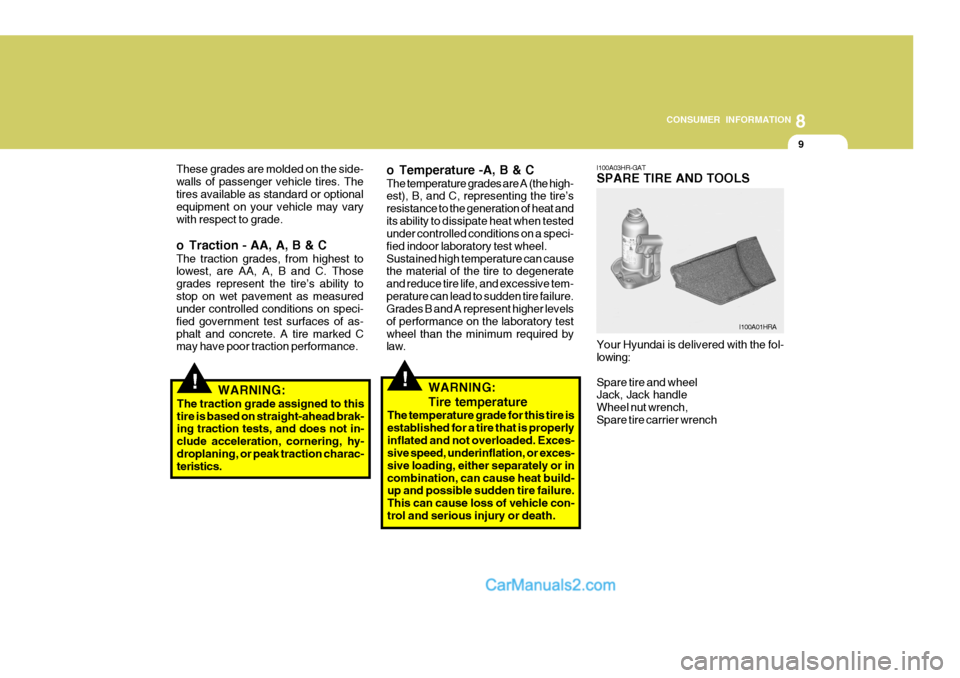
8
CONSUMER INFORMATION
9
I100A03HR-GAT SPARE TIRE AND TOOLS Your Hyundai is delivered with the fol- lowing: Spare tire and wheel Jack, Jack handle Wheel nut wrench,Spare tire carrier wrench
I100A01HRA
These grades are molded on the side- walls of passenger vehicle tires. Thetires available as standard or optional equipment on your vehicle may vary with respect to grade.
o Traction - AA, A, B & C The traction grades, from highest to lowest, are AA, A, B and C. Those grades represent the tire’s ability tostop on wet pavement as measured under controlled conditions on speci- fied government test surfaces of as-phalt and concrete. A tire marked C may have poor traction performance. o Temperature -A, B & C The temperature grades are A (the high- est), B, and C, representing the tire’s resistance to the generation of heat andits ability to dissipate heat when tested under controlled conditions on a speci- fied indoor laboratory test wheel.Sustained high temperature can cause the material of the tire to degenerate and reduce tire life, and excessive tem-perature can lead to sudden tire failure. Grades B and A represent higher levels of performance on the laboratory testwheel than the minimum required by law.
!WARNING:
The traction grade assigned to this tire is based on straight-ahead brak- ing traction tests, and does not in- clude acceleration, cornering, hy-droplaning, or peak traction charac- teristics.!WARNING: Tire temperature
The temperature grade for this tire is established for a tire that is properlyinflated and not overloaded. Exces- sive speed, underinflation, or exces- sive loading, either separately or incombination, can cause heat build- up and possible sudden tire failure. This can cause loss of vehicle con-trol and serious injury or death.
Page 207 of 217
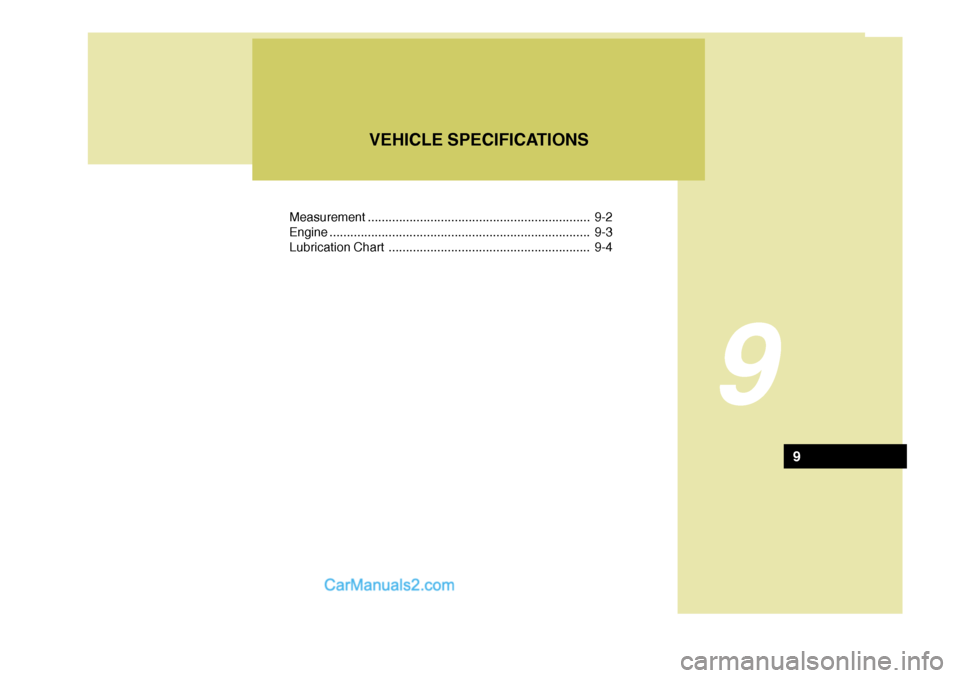
Measurement................................................................ 9-2
Engine ........................................................................... 9-3
Lubrication Chart .......................................................... 9-4
9
VEHICLE SPECIFICATIONS
9
Page 208 of 217
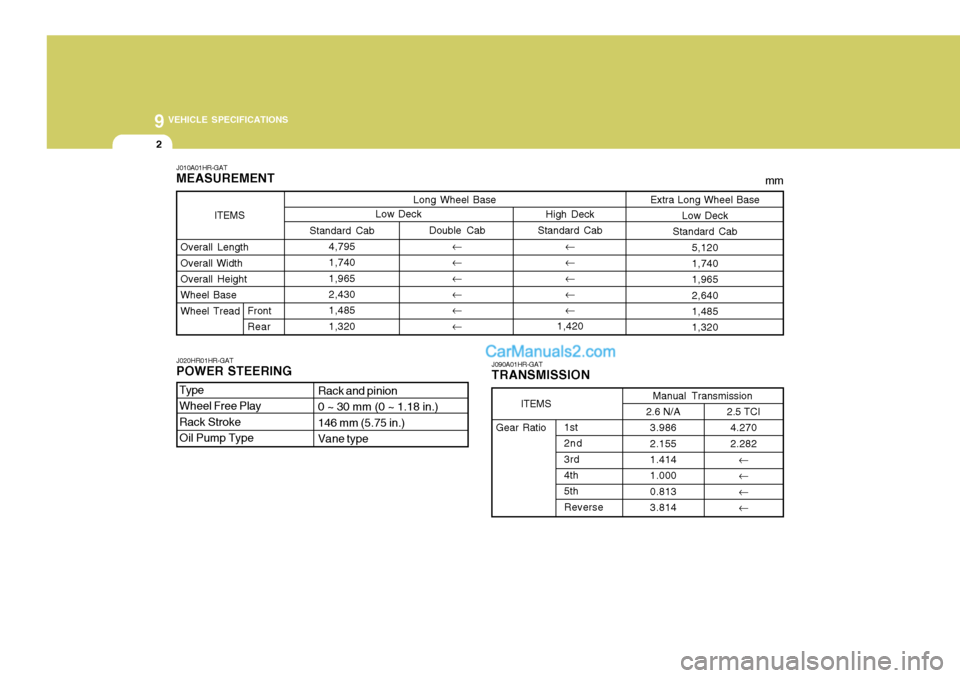
9 VEHICLE SPECIFICATIONS
2
1st 2nd3rd 4th 5thReverse
Double Cab
��� � ��
Standard Cab
4,795 1,740 1,9652,430 1,485 1,320 High Deck
Standard Cab ��� � �
1,420
TypeWheel Free PlayRack Stroke Oil Pump Type
Rack and pinion 0 ~ 30 mm (0 ~ 1.18 in.)146 mm (5.75 in.) Vane type
J020HR01HR-GAT POWER STEERING
Long Wheel Base
Front Rear mm
ITEMS
Overall Length Overall WidthOverall Height Wheel Base Wheel Tread
Extra Long Wheel Base Low Deck
Standard Cab
5,120 1,740 1,965 2,6401,485 1,320
J010A01HR-GAT MEASUREMENT
Low Deck
J090A01HR-GATTRANSMISSION Manual Transmission
2.6 N/A 3.986 2.1551.414 1.000 0.8133.814
ITEMS
Gear Ratio2.5 TCI 4.270 2.282
� � ��
Page 209 of 217
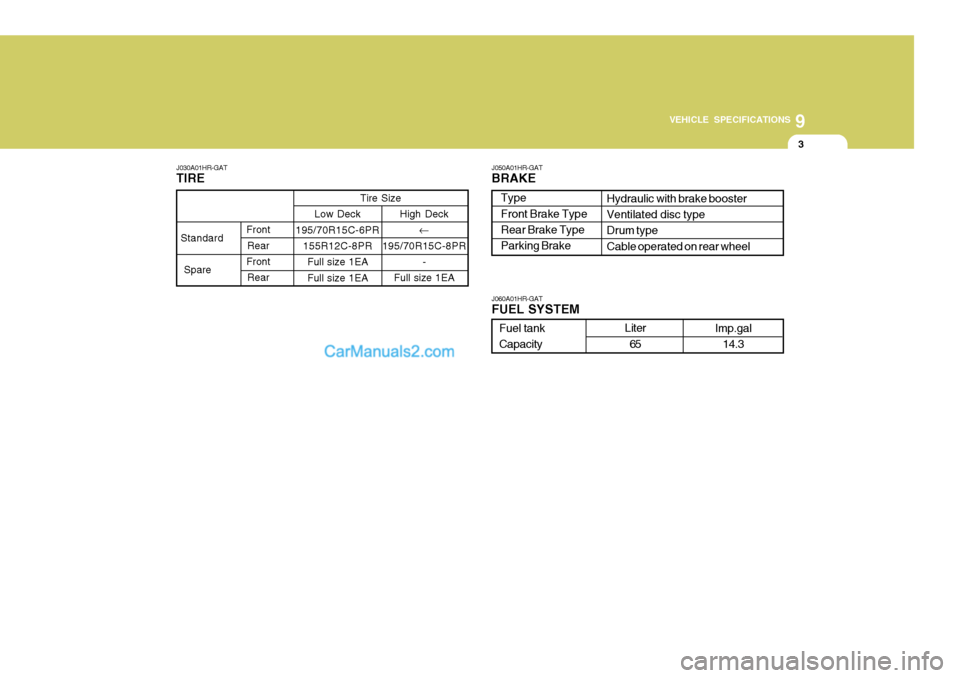
9
VEHICLE SPECIFICATIONS
3
J030A01HR-GAT TIRE
Hydraulic with brake booster Ventilated disc type Drum type Cable operated on rear wheel
J060A01HR-GAT FUEL SYSTEM
J050A01HR-GATBRAKE
Type Front Brake TypeRear Brake Type Parking Brake
Front Rear Front Rear Tire Size
Low Deck
195/70R15C-6PR 155R12C-8PR
Full size 1EAFull size 1EAStandard Spare
High Deck �
195/70R15C-8PR -
Full size 1EA
Fuel tank Capacity Liter
65 Imp.gal
14.3
Page 210 of 217
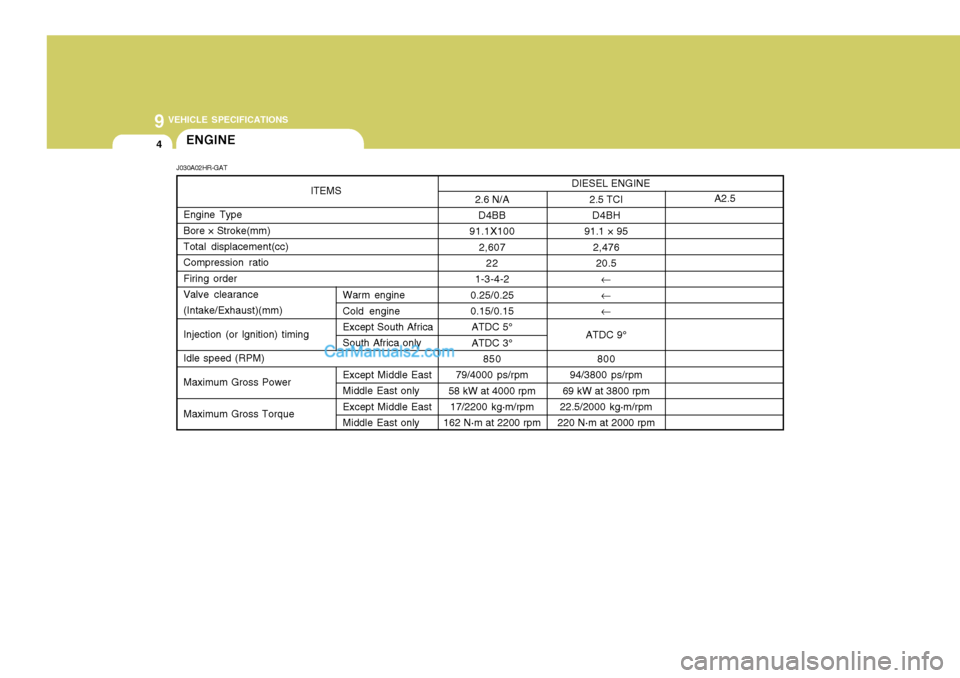
9 VEHICLE SPECIFICATIONS
4
ITEMS
Engine Type Bore × Stroke(mm) Total displacement(cc) Compression ratioFiring order Valve clearance (Intake/Exhaust)(mm) Injection (or lgnition) timingIdle speed (RPM)Maximum Gross Power Maximum Gross TorqueENGINE
J030A02HR-GAT DIESEL ENGINE
2.6 N/A D4BB
91.1X100
2,60722
1-3-4-2
0.25/0.25 0.15/0.15
ATDC 5° ATDC 3° 850
79/4000 ps/rpm
58 kW at 4000 rpm 17/2200 kg·m/rpm
162 N·m at 2200 rpm
2.5 TCI D4BH
91.1 × 95
2,47620.5
� � �
ATDC 9° 800
94/3800 ps/rpm
69 kW at 3800 rpm
22.5/2000 kg·m/rpm
220 N·m at 2000 rpm
Warm engine Cold engineExcept South Africa South Africa only Except Middle East Middle East only Except Middle EastMiddle East only
A2.5